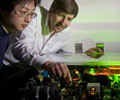| AMP: Laser frequency combs for astrophysics (astro-combs) | ||||
|
We have developed a new technique using laser frequency combs to improve the accuracy and stability of wavelength calibration of astrophysical spectrographs by up to two orders of magnitude. This "astro-comb" will provide a key advance in the resolution of changes in astrophysical Doppler shifts and redshifts, and thus may allow the discovery of Earth-like planets and new measurements of astrophysical dynamics relevant to cosmology. Both of the leading techniques to find exoplanets rely on the planet's very small effect on its star. The radial velocity technique measures the star's "wobble" (and hence Doppler shift) due to the planet's gravitational pull as it circles; while the transit technique measures the dimming of a star's light as a planet passes in front of it. With current technology, both of these techniques can identify relatively large planets that have a noticeable effect on their star. Detection of the very small Doppler shifts (<10 cm/s) induced by smaller, rocky planets, like Earth and Mars, will require improved wavelength calibration that can only be provided by astro-combs. The astro-comb uses a mode-locked laser frequency comb and a Fabry-Perot filtering cavity, linked to an atomic clock, to provide an accurate and stable wavelength standard well-suited to astrophysical spectrographs and against which light from a star can be measured. We have developed prototype astro-combs and tested them successfully at astronomical observatories. We are currently developing an astro-comb to search for Earth-like planets as part of the HARPS-North project.
Project Links
People
C.H. Li, D. Philips, R.L. Walsworth |

Ron Walsworth and Chih-Hao Li are shown adjusting a Ti:sapphire laser frequency comb, which can be used to improve the accuracy and stability of wavelength calibration of astrophysical spectrographs by up to two orders of magnitude. This astro-comb will provide a key advance in the resolution of changes in astrophysical Doppler shifts and redshifts, and thus may allow the discovery of Earth-like planets and new measurements of astrophysical dynamics relevant to cosmology.
| |||




